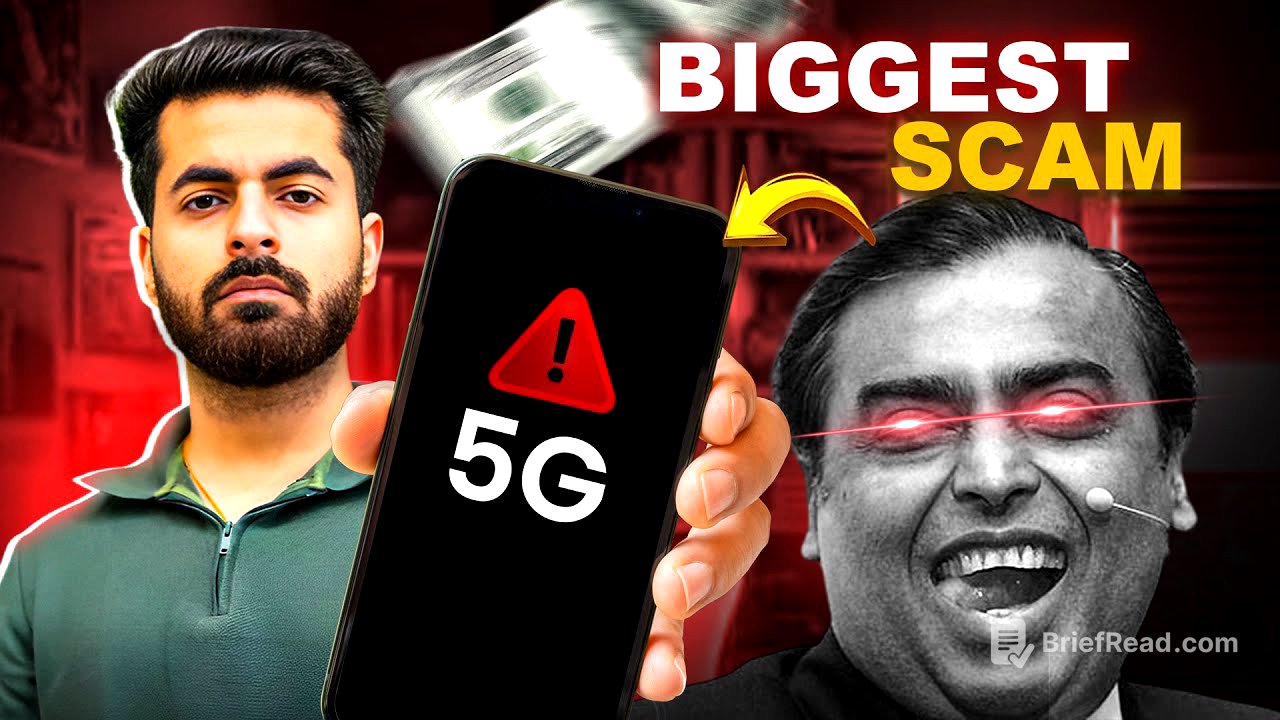TLDR;
This video discusses the current state of 5G in India, addressing why its performance often doesn't match the promised capabilities. It explores the different approaches taken by Jio and Airtel in deploying 5G, the significance of spectrum allocation, the critical role of fiber infrastructure, and the push for "Made in India" technology. The video also touches on the misleading nature of the 5G icon on phones and the economic factors influencing the telecom industry, ultimately arguing that true 5G is geared more towards industrial applications than individual consumers.
- Jio and Airtel adopted different strategies for 5G deployment, impacting user experience.
- Spectrum allocation and the 700 MHz band play a crucial role in coverage and speed.
- Inadequate fiber infrastructure is a major bottleneck for 5G performance.
- The "Made in India" initiative faces challenges in matching the performance of established global technologies.
- The 5G icon on phones can be misleading, as actual performance may vary.
- Telecom companies are likely to introduce tiered pricing for 5G services.
Introduction: The Promise and Reality of 5G in India [0:00]
The video starts by questioning why the 5G experience in India often falls short of expectations, despite the promises of gigabit speeds and zero latency. It highlights the discrepancy between advertised capabilities and actual user experience, particularly in cities like Mumbai, where download speeds are surprisingly slow compared to smaller cities like Jaipur. The video sets the stage for exploring the underlying reasons behind this disconnect, hinting at a complex interplay of factors including network infrastructure, spectrum allocation, and strategic decisions by telecom operators.
Jio vs. Airtel: Two Different Paths to 5G [1:08]
The video contrasts the approaches of Reliance Jio and Airtel in deploying 5G. Jio opted for a standalone network ("True 5G"), building a dedicated infrastructure exclusively for 5G traffic, which is more expensive and time-consuming but promises to unlock the full potential of 5G, including ultra-low latency. Airtel, on the other hand, chose a non-standalone architecture for its 5G Plus network, leveraging its existing 4G infrastructure as a backbone, which allows for faster and cheaper rollout but limits the network's ability to achieve true low latency. Despite Jio's technologically superior architecture, Airtel currently provides a better and more consistent 5G experience to users, according to Open Signal's report.
The Spectrum Auction: A Multi-Billion Dollar Gamble [3:12]
The video explains the significance of the 2022 spectrum auction, where the Indian government sold radio frequencies crucial for carrying calls, messages, and digital data. Reliance Jio emerged as the biggest spender, acquiring spectrum worth ₹88.78 crore, double the amount spent by Airtel. The video highlights that not all spectrums are equal, categorizing them into low band (700 MHz), mid-band (3300 MHz), and high band, each offering different trade-offs between coverage and speed. Jio's significant investment in the low band 700 MHz spectrum, which Airtel deemed too expensive, aims to provide nationwide 5G coverage, even in areas where Airtel cannot reach. However, the 700 MHz band offers speeds comparable to mediocre 4G, leading to a situation where users see the 5G icon but experience slower performance.
The Fiber Bottleneck: India's Hidden Weakness [5:57]
The video identifies the lack of adequate fiber infrastructure as a major bottleneck for 5G performance in India. While 5G towers promise high data transfer rates, they require high-capacity fiber connections to the internet to function effectively. As of early 2024, only 38% of India's telecom towers are connected to fiber, compared to 80-90% in countries leading the 5G race. The remaining towers rely on older wireless technology like microwave backhaul, which significantly limits data speeds and causes network congestion. The video criticizes the slow progress of government programs like the National Broadband Mission and Bharat Net, which aim to connect every village with fiber, attributing the delays to bureaucratic hurdles and inconsistent regulations across different states and municipalities.
Made in India Gamble: The Quest for Technological Independence [8:08]
The video discusses the push for "Made in India" solutions in the telecom sector, with Jio claiming that its 5G network runs on in-house hardware and software. While reducing dependence on foreign companies is a desirable goal, building a telecom network stack is a complex engineering challenge. The video questions whether these new homegrown technologies can match the performance and reliability of established global technologies from companies like Ericsson, Nokia, and Samsung. Ookla's report suggests that Jio's standalone 5G network performance has degraded between 2023 and 2024, potentially due to unoptimized software and hardware integration issues. The video frames this as a trade-off between long-term strategic independence and short-term reliability.
The 5G Icon Lie: Exposing the Truth About Your Phone's Display [9:36]
The video reveals that the 5G icon on phones can be misleading, as it doesn't guarantee fast performance. On non-standalone (NSA) networks like Airtel, the phone is connected to both 4G and 5G towers simultaneously, with the 4G connection acting as an anchor. If the 4G network is congested, data speeds will drop, regardless of the 5G signal strength. Even on Jio's standalone network, if the phone is connected to the 700 MHz band, it will display the 5G icon but deliver 4G-like speeds. The video argues that the 5G icon has become a connectivity indicator rather than a guarantee of performance, and telecom companies are not transparent about this issue.
Who is 5G Really For? The Industrial Revolution [11:16]
The video argues that the primary beneficiaries of 5G technology are not individual consumers but industries. While marketing campaigns have focused on faster download speeds for consumers, the real value of 5G lies in its potential for industrial applications, such as connecting factories, smart cities, and millions of sensors simultaneously. The key features of 5G, including Ultra Reliable Low Latency Communication (URLLC) and Massive Machine Type Communication (mMTC), are geared towards enabling automation, real-time quality checks, and remote operations in various industries. The video highlights fixed wireless access (FWA) solutions like Jio Air Fiber and Airtel Extreme Air Fiber, as well as private 5G networks for factories and ports, as examples of 5G's industrial applications.
The Economics of 5G: Following the Money [13:12]
The video examines the economic challenges facing the Indian telecom industry, which is burdened by a huge debt of ₹6.6 lakh crore due to 5G rollouts. To repay this debt, telecom companies need to increase their Average Revenue Per User (ARPU). The video describes the strategies being used to achieve this, including offering unlimited 5G for free to acquire customers and increase data consumption, followed by "tariff repair" measures like removing low-cost plans and introducing tiered pricing. The video predicts that telecom companies will soon offer premium 5G plans with guaranteed high speeds for a higher price, effectively charging users more for the performance they were initially promised.
The Final Truth About 5G: A Shared Blame [15:10]
The video concludes that there is no single entity to blame for the slow 5G experience in India, attributing it to a shared responsibility. It blames telecom companies for overpromising and prioritizing rapid rollouts over proper infrastructure, the national infrastructure for lacking systematic planning, and government policies for setting high spectrum prices that led to debt. The video also acknowledges that consumers share some blame for expecting advanced technology at unrealistically low prices. It emphasizes that the true potential of 5G, with its ability to create smart cities and enable remote surgeries, is not a myth but is not yet widely available. The video calls for good investment in fiber, transparency in marketing, and a willingness among consumers to pay a fair price for premium service to realize the full potential of 5G in India.







![Baray Bhaiya Episode 74 - [Eng Sub] - Aijaz Aslam - Maya Khan - Rabya Kulsoom - 28th August 2025](https://wm-img.halpindev.com/p-briefread_c-10_b-10/urlb/aHR0cDovL2ltZy55b3V0dWJlLmNvbS92aS9vdHFoeWxDV01ERS9ocWRlZmF1bHQuanBn.jpg)

